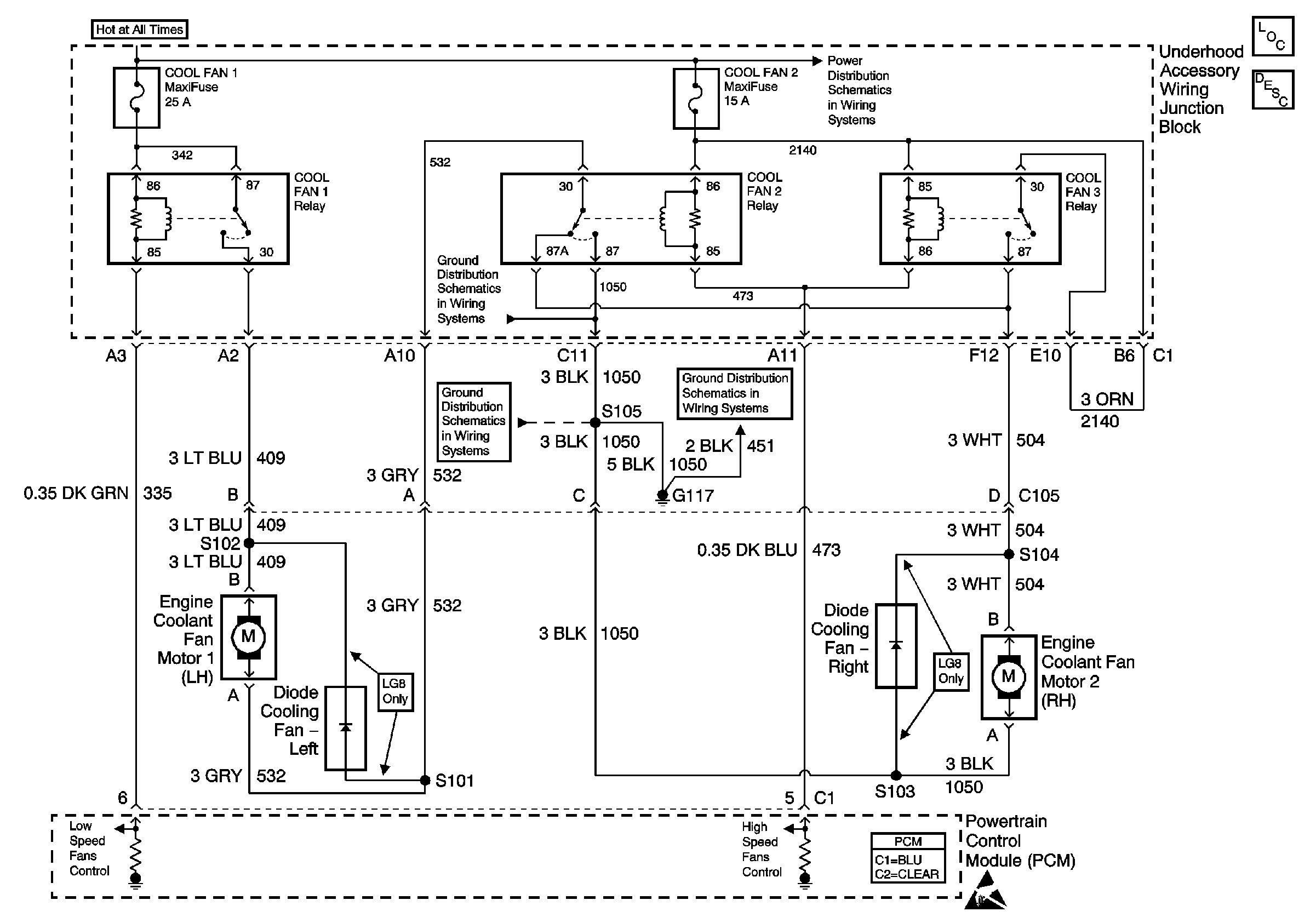Refer to Engine Controls Schematic
Cooling Fans

.
Circuit Description
Output driver modules (ODMs) are used by the powertrain control module (PCM) to turn ON many of the current-driven devices that are needed to control various engine and transaxle functions. Each ODM is capable of controlling up to 7 separate outputs by applying ground to the device which the PCM is commanding on. Unlike the quad driver modules (QDMs) used in prior model years, ODMs have the capability of diagnosing each output circuit individually. If an improper voltage level has been detected on ODM B output 1, which controls the Cooling Fan 1 relay, DTC P0480 will set.
Conditions for Setting the DTC
| • | The ignition is ON. |
| • | An improper voltage level has been detected on ODM B output 1, the low speed fans relay driver circuit. |
| • | The above conditions are present for at least 30 seconds. |
Action Taken When the DTC Sets
| • | The PCM will illuminate the malfunction indicator lamp (MIL) during the second consecutive trip in which the diagnostic test has been run and failed. |
| • | The PCM will store conditions which were present when the DTC set as Freeze Frame/Failure Records data. |
Conditions for Clearing the MIL/DTC
| • | The PCM will turn OFF the malfunction indicator lamp (MIL) during the third consecutive trip in which the diagnostic has run and passed. |
| • | The history DTC will clear after 40 consecutive warm-up cycles have occurred without a malfunction. |
| • | The DTC can be cleared by using a scan tool. |
Diagnostic Aids
Inspect for the following conditions:
Many situations may lead to an intermittent condition. Perform each inspection or test as directed.
Important: : Remove any debris from the connector surfaces before servicing a component. Inspect the connector gaskets when diagnosing or replacing a component. Ensure that the gaskets are installed correctly. The gaskets prevent contaminate intrusion.
| • | Loose terminal connection |
| - | Use a corresponding mating terminal to test for proper tension. Refer to Testing for Intermittent Conditions and Poor Connections , and to Connector Repairs in Wiring Systems for diagnosis and repair. |
| - | Inspect the harness connectors for backed out terminals, improper mating, broken locks, improperly formed or damaged terminals, and faulty terminal to wire connection. Refer to Testing for Intermittent Conditions and Poor Connections , and to Connector Repairs in Wiring Systems for diagnosis and repair. |
| • | Damaged harness--Inspect the wiring harness for damage. If the harness inspection does not reveal a problem, observe the display on the scan tool while moving connectors and wiring harnesses related to the sensor. A change in the scan tool display may indicate the location of the fault. Refer to Wiring Repairs in Wiring Systems for diagnosis and repair. |
| • | Inspect the powertrain control module (PCM) and the engine grounds for clean and secure connections. Refer to Wiring Repairs in Wiring Systems for diagnosis and repair. |
If the condition is determined to be intermittent, reviewing the Snapshot or Freeze Frame/Failure Records may be useful in determining when the DTC or condition was identified.
Test Description
The numbers below refer to the step numbers on the diagnostic table.
-
The Powertrain On Board Diagnostic (OBD) System Check prompts you to complete some basic tests and store the Failure Records data on the scan tool.
-
Listen for an audible click when the relay operates. Command both the ON and OFF states. Repeat the commands as necessary.
-
This step tests for voltage at the coil feed side of the relay.
-
This step verifies that the PCM is providing ground to the relay.
-
This step tests if ground is constantly being applied to the relay.
-
The PCM utilizes an Electrically Erasable Programmable Read Only Memory (EEPROM). When the PCM is replaced, the new PCM must be programmed.
Step | Action | Values | Yes | No |
|---|---|---|---|---|
Did you perform the Powertrain On Board Diagnostic (OBD) System Check? | -- | Go to Step 2 | ||
Does the relay turn ON and OFF with each command? | -- | Go to Diagnostic Aids | Go to Step 3 | |
Does the test lamp illuminate? | -- | Go to Step 4 | Go to Step 10 | |
Does the test lamp turn ON and OFF with each command? | -- | Go to Step 8 | Go to Step 5 | |
Does the test lamp remain illuminated with each command? | -- | Go to Step 7 | Go to Step 6 | |
6 |
Did you find and correct the condition? | -- | Go to Step 13 | Go to Step 9 |
7 |
Did you find and correct the condition? | -- | Go to Step 13 | Go to Step 9 |
8 |
Did you find and correct the condition? | -- | Go to Step 13 | Go to Step 11 |
9 |
Did you find and correct the condition? | -- | Go to Step 13 | Go to Step 12 |
10 |
Important: If the fuse is blown, test each branch of the circuit for a short to ground and repair as necessary. Repair the feed circuit of the relay. Refer to Wiring Repairs in Wiring Systems. Is the action complete? | -- | Go to Step 13 | -- |
11 | Replace the relay. Is the action complete? | -- | Go to Step 13 | -- |
|
Important: The replacement PCM must be programmed. Replace the PCM. Refer to Powertrain Control Module Replacement/Programming . Is the action complete? | -- | Go to Step 13 | -- | |
13 |
Does the DTC reset? | -- | Go to Step 2 | System OK |
